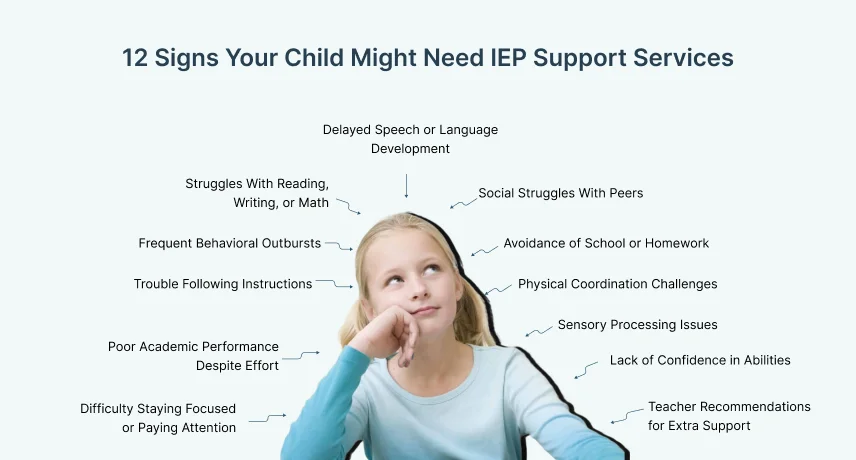12 Signs Your Child Might Need IEP Support Services

Stephanie Tsapakis
|
Updated on Feb 02, 2025 · 6 min read


Stephanie Tsapakis
|
Updated on Feb 02, 2025 · 6 min read

Has your gut been telling you that your child seems to be struggling in school, and you cannot figure out why? Do you find yourself basically doing your child's homework for them, instead of them being able to indepenedently complete the work? Good news! There are ways your school can help.
An Individualized Education Program (IEP) is a powerful document designed to support children with unique educational needs throughout their educational journey. It levels the playing field, to ensure that every child has equal access to the type of education that they need. A child's IEP team, comprised of teachers and administrators from the school, create individual goals and track the child's growth in realation to those goals. Research shows that the sooner a child is able to be identified with any learning challenges, they more positive their intervention results will be.
This blog will explore 12 common signs that may indicate your child needs an IEP and shrea some of the benefits of these services. We will also share actionable steps parents can take to advocate for their child’s needs. Understanding these signs is the first step in unlocking your child's potential and setting them on the path to reaching their full academic potential!
An IEP is a document created by a team of professional at the school that is meant to detail individual goals for a child with a disability. The IEP team must include an administrator, a general education teacher, a special education teacher, parents, and any professionals providing related services, such as Speech, Occupational Therapy, or Physical Therapy.
IEPs create specific goals that are individualized to your child - hence the “i” in IEP. Teachers then use specific types of instruction along with accommodations to help your child be more successful in school. These services cater to a range of needs, including learning disabilities (such as ADHD, dyslexia, dysgraphis, math calculation and problem solving issues, etc...), developmental delays (intellectual disabilities), behavioral challenges, and physical or sensory processing difficulties.
An IEP is specific to students who both 1) have a qualifying disability, and 2) need special education services. For students that perhaps have certain educational or emotional struggles, but do not need specifically designed instruction or modifications to the curriculum to succeed, a 504 plan may be more appropriate. A 504 plan allows a student to receive accommodations, such as extended time or oral adminstration of assessments, without also receiving special education services.

At LD Expert, we specialize in working with children that have learning differences. Some services we provide are:
IEPs have many benefits, including:
Trust your gut! If you feel your child is struggling in school, start with their clasroom teacher, and assert your rights to request a formal evaluation. With the right resources and accommodations, children can overcome challenges and thrive in their academic journey.
If you’ve observed any of the signs mentioned in this blog, don’t hesitate to seek expert guidance. Administrators, teachers, and organizations like LD Expert care about your child’s education, and genuinely want to see them succeed!
You've got this, and we are proud of all parents out there advocating for the education their child needs and deserves.
Looking for personalized support for your child's learning journey?
Our tutoring and dyslexia intervention services are tailored to students with learning differences. Whether it's reading, writing, or other challenges, our team offers one-on-one guidance.
Start with a consultation!Answers to frequently asked questions about IEP support
Diagnosing a child with special needs involves a multi-faceted approach, typically including developmental screenings, medical evaluations, and educational assessments. These assessments are often conducted by a team of specialists, including pediatricians, psychologists, and special education experts.
A child may need an IEP if they have a disability that affects their educational performance and requires specialized instruction and related services. The process involves an evaluation to determine if the child qualifies for special education services based on specific criteria related to their disability.
A child should be evaluated for an IEP when there are concerns about their academic progress, behavior, or development that significantly impact their ability to learn in the general education setting.
Common diagnoses for students for IEPs include a range of learning disabilities, developmental delays, and other conditions that affect learning and development. These can include dyslexia, ADHD, autism, speech impediments, and various emotional or behavioral disorders.
The typical age for diagnosis is around second to fourth grade, but parents or teachers may notice a child struggling as early as kindergarten.
Stay updated with our latest blog posts.
Cart